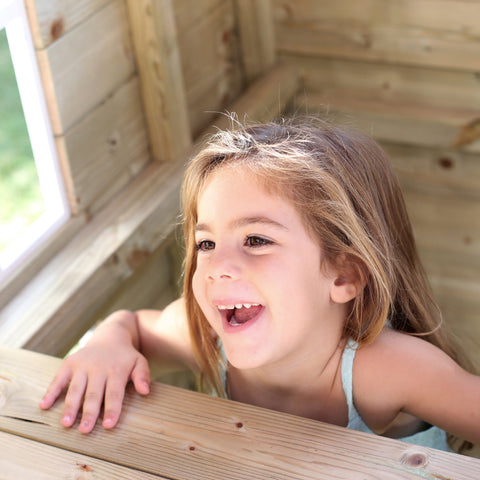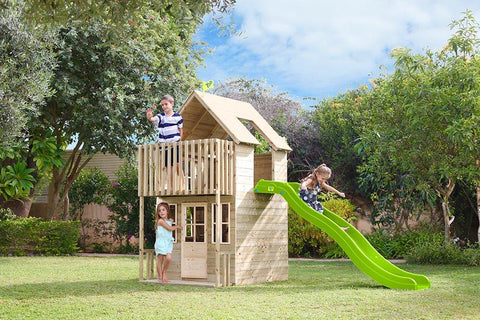A 2 storey playhouse is not just an ordinary structure; they are towering beacons of childhood wonder, promising endless adventures and boundless creativity. These multi-level edifices invite children to ascend their staircases and explore the world from new heights, igniting their imaginations and fostering a sense of exploration. Yet, amidst the excitement and thrill of play, ensuring the safety of these majestic garden buildings is of utmost importance.
In this comprehensive guide, we delve into the essential safety considerations for two-storey playhouses, delving deep into the structural integrity, age-appropriate features, and supervision practices necessary to create a secure and enjoyable play environment. From reinforced joints to safety rails, from age limits to close supervision, we leave no stone unturned in our quest to promote safe play in these towering havens of adventure.
Join us as we navigate the intricate landscape of two-storey playhouses, uncovering the secrets to creating a space where children can explore, imagine, and play with confidence and peace of mind. Let us embark on this journey together, ensuring that every ascent to the upper level is met with joy and excitement, and every moment of play is filled with laughter and delight.
Structural Stability and Durability
Structural stability and durability are the cornerstones of safety in two-storey playhouses, ensuring that these towering structures can withstand the rigours of energetic play and unpredictable weather conditions. As guardians of childhood adventure, it is imperative to prioritise these aspects when you choose a playhouse for young explorers.

Start by buying a playhouse model crafted from high quality materials renowned for their resilience in outdoor settings. Pressure treated, weather resistant wood and durable plastic are excellent choices, offering longevity and reliability even in the face of harsh environmental factors. These materials should be treated to withstand UV exposure, moisture, and temperature fluctuations, ensuring that the playhouse remains sturdy and intact over time.
Additionally, pay close attention to the design and construction of the playhouse, particularly in areas prone to stress and wear. Reinforced joints, sturdy support beams, and safety hinges are essential features that contribute to the structural integrity of the playhouse. These components not only prevent accidents such as collapses or breakages but also ensure the long-term durability of the structure, providing children with a safe and reliable space to unleash their imaginations.
Whether you choose a wooden playhouse or plastic playhouse, by prioritising structural stability and durability, parents and carers can rest assured that their children's play experiences are not only exhilarating but also safe and secure. With a solid foundation and robust construction, two-storey playhouses become more than just structures—they become enduring symbols of adventure and exploration in the great outdoors.
Key Safety Features
In addition to safety rails and guardrails, there are several other key safety features that should be integrated into two-storey playhouses to ensure a secure play environment for children. Safety hinges on doors and windows are essential components that prevent the risk of fingers getting caught or trapped, providing peace of mind for both parents and children during play sessions. These hinges allow doors and windows to close smoothly and securely without the risk of accidental closure.
Furthermore, non-slip surfaces on staircases or ladders are vital for preventing slips and falls, especially in wet or slippery conditions. These surfaces provide enhanced traction, reducing the risk of accidents as children ascend or descend between levels, especially if built upon paving slabs or concrete ground. Additionally, incorporating rounded edges and smooth surfaces throughout the playhouse minimises the risk of injuries from sharp edges or rough materials. A spirit level can be used to check the surface of the playhouse base is level.
It's also crucial to ensure that all materials used in the construction of the playhouse are non-toxic and free from harmful chemicals, reducing the risk of exposure to hazardous substances during play.
Regular maintenance and inspection of safety features are essential to identify any potential hazards or wear and tear, allowing for timely repairs or replacements to maintain the integrity of the playhouse.
By integrating these key safety features, parents and caregivers can create a safe and secure play environment where children can explore, imagine, and play with confidence and peace of mind.

Age Limits and Supervision
Establishing age limits for the use of two-storey playhouses is vital to ensure the safety of younger children. While older children may have the coordination and balance to navigate the upper level safely, younger children may be more susceptible to accidents.
It would be a good idea to set a minimum age requirement for accessing the upper level and provide close supervision for younger children during play. Adults should actively monitor children's activities, especially when using stairs, climbing features, or engaging in rough play.





